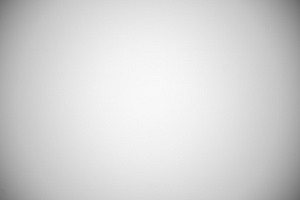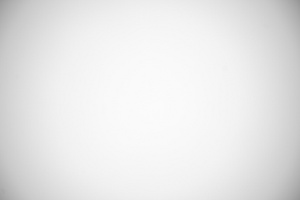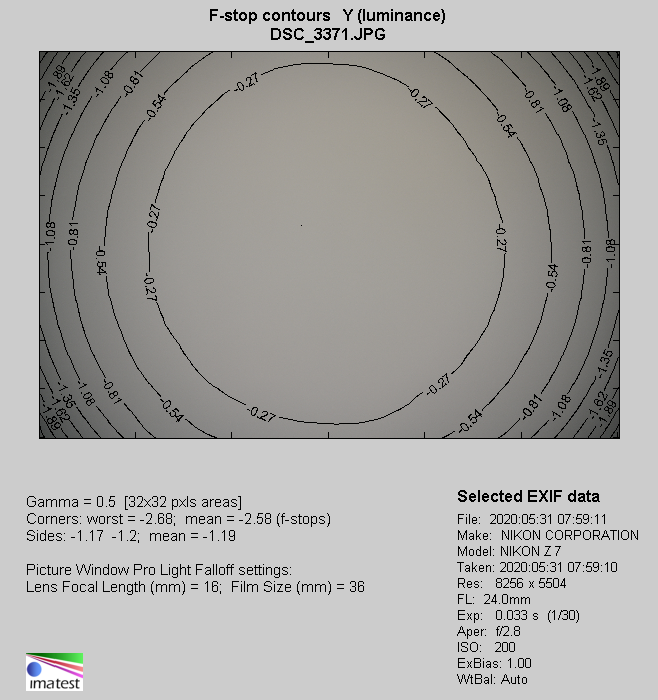Nikon Nikkor Z 24-70 mm f/2.8 S
8. Vignetting
| Z7, APS-C, JPEG, 24ámm, f/2.8 | Z7, APS-C, JPEG, 24ámm, f/4.0 |

|

|
| Z7, APS-C, JPEG, 45ámm, f/2.8 | Z7, APS-C, JPEG, 45ámm, f/4.0 |

|

|
| Z7, APS-C, JPEG, 70ámm, f/2.8 | Z7, APS-C, JPEG, 70ámm, f/4.0 |

|

|
The Nikon Z7 body features a possibility to switch off vignetting correction and we decided to use it - accordingly, JPEG files, presented above, are not vignetting corrected by the camera. In the case of this lens we also switched off distortion correction so vignetting results on JPEG files are, within the margin of error, the same as on RAW files. It allows us to deal with one kind of files in our analysis.
Please Support UsIf you enjoy our reviews and articles, and you want us to continue our work please, support our website by donating through PayPal. The funds are going to be used for paying our editorial team, renting servers, and equipping our testing studio; only that way we will be able to continue providing you interesting content for free. |
- - - - - - - - - - - - - - - - - - - - - - - - - - - - - - - - - - - - - - - - - - - - - - - -
In the case of the APS-C/DX sensor problems concerning vignetting category are practically non-existent. At 24 mm and by f/2.8 brightness loss in frame corners amounts to just 17% (−0.54 EV) and it decreases to an imperceptible value of 11% (−0.33 EV) on stopping down the aperture to f/4.0.
In the middle of the focal range the results are even a tad better: by f/2.8 vignetting is 16% (−0.51 EV), and by f/4.0 only 9% (−0.29 EV).
Very similar results you get at 70 mm where, at the maximum relative aperture, the aberration, described in this chapter, reaches 17% (−0.53 EV), and by f/4.0 it decreases to 9% (−0.28 EV).
Still, only full frame can be a real test for the Nikkor lens, examined here. Let's glance at some thumbnails, presented below.
| Z7, FF, JPEG, 24ámm, f/2.8 | Z7, FF, JPEG, 24ámm, f/4.0 |

|

|
| Z7, FF, JPEG, 45ámm, f/2.8 | Z7, FF, JPEG, 45ámm, f/4.0 |

|

|
| Z7, FF, JPEG, 70ámm, f/2.8 | Z7, FF, JPEG, 70ámm, f/4.0 |

|

|
A difficult combination of the widest angle available and f/2.8 aperture means you can lose as much as 59% (−2.58 EV) of light in the frame corners. That's a lot, especially if you compare this result to that of reflex camera lenses which experience less problems with telecentricity. For example the Nikkor AF-S 24-70 mm f/2.8E ED VR showed here a value of about 46%.
Stopping down the aperture helps with vignetting correction but the decrease is not as steep as you would wish. By f/4.0 the aberration, described in this chapter, reaches 46% (−1.77 EV), by f/5.6 it amounts to 41% (−1.53 EV), by f/8.0 it is close to 38% (−1.38 EV), and by f/11 it still remains noticeable with 34% (−1.19 EV) of light fall-off. You are able to notice vignetting effects even by f/16 where it is still 30% (−1.01 EV).
The situation in the middle of the focal range is better but it doesn't mean you won't see any vignetting at all, quite the opposite. By f/2.8 brightness loss reaches a very high value of 52% (−2.14 EV), by f/4.0 it gets to 37% (−1.32 EV), and by f/5.6 to 27% (−0.91 EV). Employing the f/8.0 relative aperture makes that aberration decrease to 22% (−0.61 EV), and by f/11 it drops to 19% (−0.61 EV). Further decrease of vignetting level you can notice by f/16 where we our measurements showed a level of 20% (−0.63 EV).
The situation of the 70 mm focal length is very similar to the performance you could observe at 45 mm. By f/2.8 vignetting reaches a very high level of 54%(−2.27 EV), and then, on stopping down the aperture to f/4.0, it drops to a value of 38% (−1.37 EV). By f/5.6, f/8.0, and f/11 we got the following results: 25% (−0.84 EV), 19% (−0.60 EV) and 16% (−0.51 EV) respectively.
| Nikon Z7, 24ámm, JPEG, f/2.8 |
 |
| Nikon Z7, 45ámm, JPEG, f/2.8 |
 |
| Nikon Z7, 70ámm, JPEG, f/2.8 |
 |






